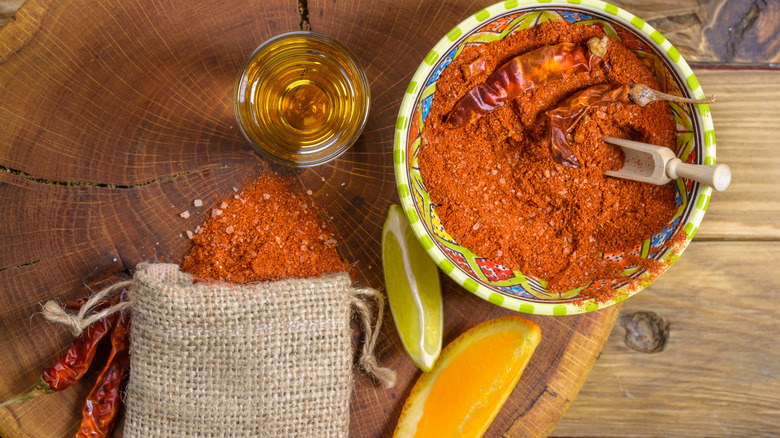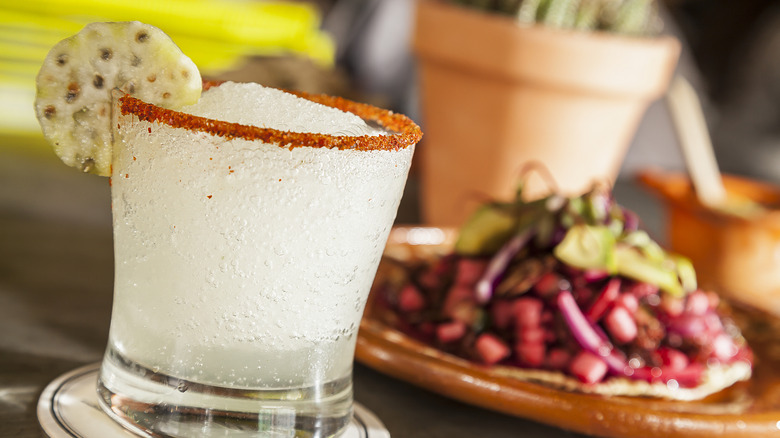What Is Sal De Gusano (Aka Worm Salt) And How Do You Use It?
Sal de gusano, meaning "worm salt" in Spanish, is a type of seasoned salt that indeed includes insects. When ground and combined with chilies and salt, these insects create a blend that is mineral-driven, salty, earthy, spicy, and smoky. The worms contribute a complex umami hit with a savory flavor reminiscent of fried fish skin or gamey chicharrones, a Mexican preparation of crispy, rendered pork skin.
The most traditional way to enjoy sal de gusano is alongside a shot of mezcal. Unlike other spirits, mezcal is a dynamic brew meant to be savored sip by sip. Often, a pour of mezcal will be accompanied by a thin slice of orange and a small pile of sal de gusano. Dip the orange into the salt, take a nibble, and then take a small sip of the mezcal. The acid, salt, and spice elevate the complex flavors of the mezcal and act as a palate cleanser between sips.
Mezcal offers a true representation of time and place. Like grapes, agave plants are heavily influenced by the land and climate in which they grow. It's not just the variety of agave that affects the taste of different types of mezcal, but also the unique terroir where the plants can spend up to 40 years growing. Imagine the synchronicity in pairing mezcal with worm salt, given that these worms have consumed the very agave used to create the spirit.
How do you make sal de gusano?
Sal de gusano is pretty much what it sounds like, except that the so-called "worms" are actually moth larvae. These larvae are pests that can be detrimental to agave plants. The red or pink variety is called chinicuiles, and the white variety is called meocuiles. The insects travel through the roots and up into the juicy leaves, feasting on the sweet agave during the rainy season.
To save the agave harvests, farmers remove these worms by hand and then prepare the larvae for consumption. While it might sound unappetizing, the tradition of eating small critters like worms goes back to ancient times. The chinicuiles and meocuiles can be sun-dried, oven-roasted, or toasted on a smooth, flat griddle known as a comal. At this point, the worms can be eaten as a snack, used as taco filling, or ground and combined with salt and chilies to make sal de gusano. After the sal de gusano blend is prepared, it is left to dry once more.
Where can you find sal de gusano?
While sal de gusano used to be almost exclusively available in Mexico through family recipes and regional specialties, it is now much more readily accessible outside the country. Specialty food companies and mezcal brands are producing it to complement their own products. You can find sal de gusano at some liquor stores, cocktail shops, and online; even Walmart offers it for purchase. Any mezcal bar worth its worm salt will have sal de gusano on the menu if ambiance is what you're after.
The taste can vary significantly based on the type of worm used and how it is prepared, the agave it has consumed, the salinity of the salt, the heat of the chilies, and the addition of extra ingredients. Salts may include other small critters — insects are the next superfood, after all — like grasshoppers. Additional elements like citrus zest, spices such as cardamom, herbs like hoja santa, and vibrant hibiscus flowers can all add intrigue to sal de gusano.
How else can you use sal de gusano?
For your mezcal sipping, serve sal de gusano alongside complementary fruits like grapefruit, apple, jicama, or watermelon. You can also use it as a spicy, umami-packed substitute for salt when rimming cocktails featuring agave-based spirits, or to balance sweet drinks like lemonade and savory beverages like Bloody Marys or micheladas.
Try sprinkling sal de gusano on a raw vegetable platter featuring radishes, cucumbers, and carrots, and add a generous squeeze of lime. Elevate freshly made potato chips or popcorn with this punchy, spicy blend. Complete your snacking spread with a Mexican-inspired take on caprese salad: Instead of using mozzarella, layer sliced fresh tomatoes with mild queso Oaxaca. Then, generously drizzle with olive oil, top with torn fresh oregano, and season with sal de gusano. Essentially, you can use sal de gusano anywhere you'd want salt but with the flavor intensity ramped up.




